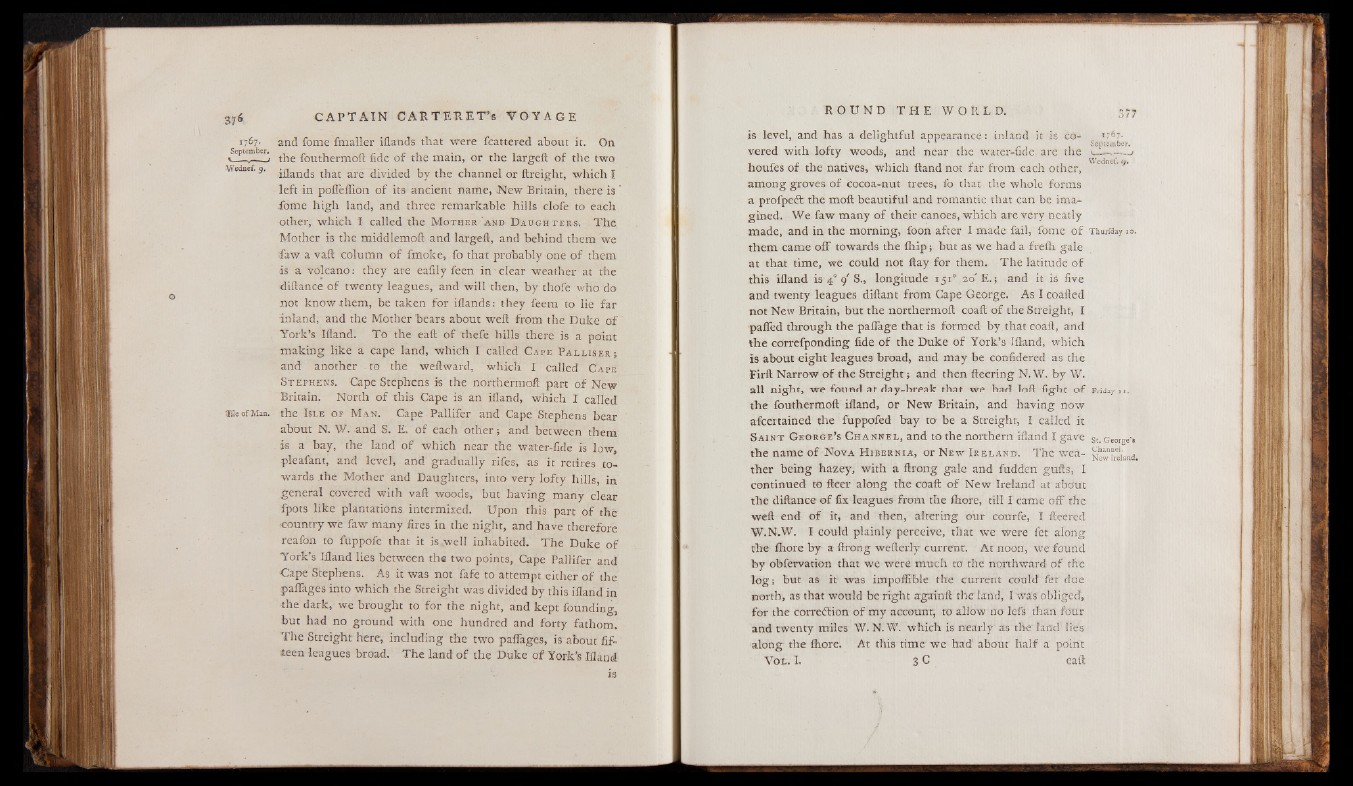
-37 f
1767- and fome fmaller iflands that were fcattered about it. On
Septem. ‘ the fouthermoft fide o f the main, or the largeft of the two
.Wedne, 9. £j2ancjs that are divided by the channel or ftreight, which I
left in poffelfion o f its ancient name, New Britain, there is '
iome high land, and three remarkable hills clofe to each
other, which I called the M o t h e r a n d D a u g h t e r s . The
Mother is the middlemoft and largeft, and behind them we
Caw a vaft column o f fmoke, fo that probably one o f them
is a volcano: they are eafily feen in clear weather at the
diftance of twenty leagues, and will then, by thofe who do
not know them, be taken for iflands: they feem to lie far
inland, and the Mother hears about weft from the Duke of
York’s Ifland. To the eaft of thefe hills there is a point
making like a cape land, which I called C a t e P a l l i s e r ;
and another to the weftward, which I called C a p e
S t e p h e n s . Cape Stephens is the northermoft part o f New
Britain. North of this Cape is an ifland, which I called
iHeofMan. the I sle o f M a n . Cape Pallifer and Cape Stephens bear
about N. W. and S. E. o f each othe r; and between them
is a bay, the land of which near the water-fide is low,
pleafant, and level, and gradually rifes, as it retires towards
the Mother and Daughters, into very lofty hills, in
general covered with vaft woods, but having many clear
fpots like plantations intermixed. Upon this part of the
country we faw many fires in the night, and have therefore
reafon to fuppofe that it is .well inhabited. The Duke of
York’s Ifland lies between the two points, Cape Pallifer and
Cape Stephens. As it was not fafe to attempt either o f the
paflages into which the Streight was divided by this ifland in
the dark, we brought to for the night, and kept founding,
but had no ground with one hundred and forty fathom.
T h e Streight here, including the two paflages, is about fif-
teen leagues broad. The land of the Duke o f York’s Ifland
is
is level, and has a delightful appearance: inland it is covered
with lofty woods, and near the water-fide are the
houfes of the natives, which Hand not far from each other,
among groves o f cocoa-nut trees, fo that the whole forms
a profpeft the moft beautiful and romantic that can be imagined.
We faw many o f their canoes, which are very neatly
made, and in the morning, foon after I made fail, fome of
them came off towards the fh ip ; but as we had a frefti gale
at that time, we could not ftay for them. The latitude of
this ifland is 40 9 'S., longitude 151° ,20'E .; and it is five
and twenty leagues diftant from Cape George. As I eoafted
not New Britain, but the northermoft coaft of the Streight, I
palled through the paflage that is formed by that coaft, and
the correfponding fide o f the Duke of York’s Ifland, which
is about eight leagues broad, and may be confidered as the
Firft Narrow o f the Streight; and then fleering N. W. by W.
all night, we found at day-break that we had loft fight of
the fouthermoft ifland, or New Britain, and having now
afcertained the fuppofed bay to be a Streight, I called it
S a i n t G e o r g e ’ s C h a n n e l , and to the northern ifland I gave
the name of N o v a H i b e r n i a , or N e w I r e l a n d . The weather
being hazey, with a ftrong gale and fudden guffs, I
continued to fleer along the coaft o f New Ireland ar about
the diftance of fix leagues from the fliore, till I came off the
weft end o f it, and then, altering our courfe, I fleered
W.N.W. I could plainly perceive, that we were fet along
the fhore by a- ftrong wefferly current. At noon, w e found
by obfervation that we were much to the northward o f the
lo g ; hut as it was impoffible the current could fet due
north, as that would be right againft the land, I was'obliged,
for the correction of my account, to allow no lefs than four
and twenty miles W. N. W. which is nearly as the land lies
along the fhore. At this time we had1 about half a point
Vox. I. 3 C eaft
1767.
September. ---~J Wetinef. 9.
Thurfday 10«
Friday u .
St. George’s
Channel.
New Ireland.